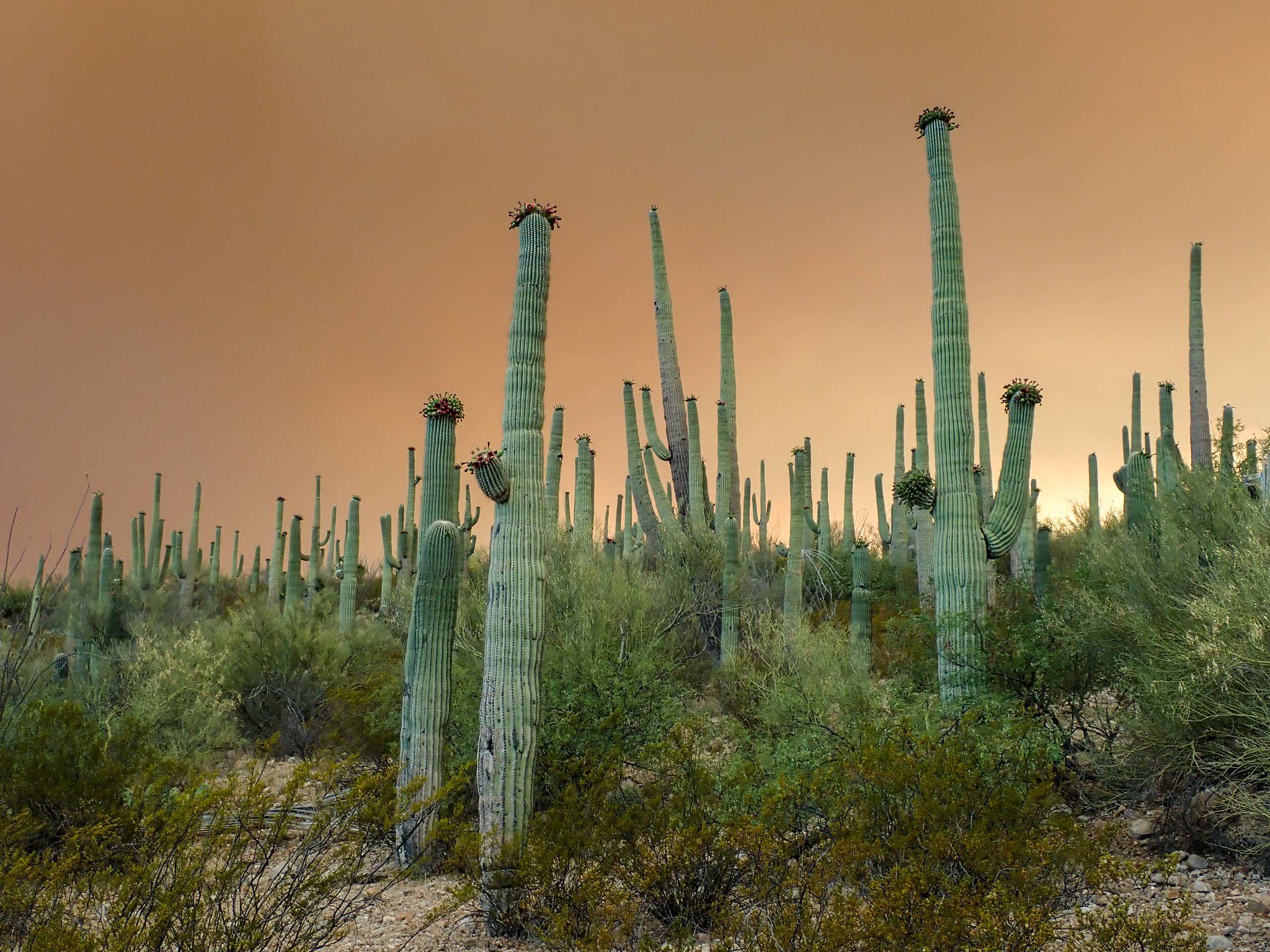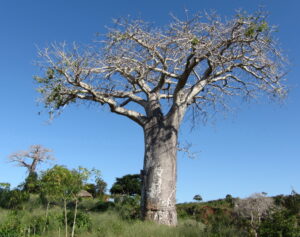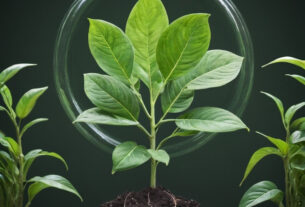In the natural world, some plants defy the odds by thriving in environments that seem inhospitable to most life forms. These extreme environments, ranging from scorching deserts to frigid tundras and saline coastal areas, pose significant challenges such as extreme temperatures, water scarcity, and high salinity. Yet, certain plant species have evolved extraordinary adaptations that enable them to not only survive but also flourish in these harsh conditions.
This article explores ten remarkable examples of such plants, each demonstrating unique strategies to cope with their specific environmental challenges. From the water-storing capabilities of the Baobab in the arid savannas of Africa to the salt-excreting mechanisms of the Ice Plant in coastal saline soils, these plants offer fascinating insights into the resilience and ingenuity of nature. Join us as we delve into the diverse and awe-inspiring ways in which these botanical marvels navigate and thrive in some of the planet’s most extreme habitats.
1. Saguaro Cactus (Carnegiea gigantea)
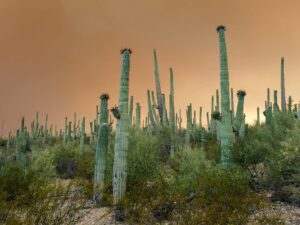
(flickr.com)
Environment: The Saguaro Cactus is a quintessential symbol of the Sonoran Desert, which extends across Arizona, California, and into Mexico’s Sonora and Baja California regions. This harsh desert environment is characterized by extremely high temperatures, intense sunlight, and minimal rainfall, often less than 10 inches annually. The ability of the Saguaro to survive in such conditions is a testament to its remarkable adaptations.
Adaptations: One of the most notable adaptations of the Saguaro Cactus is its ability to store large amounts of water in its thick, ribbed stems. This adaptation allows the cactus to endure prolonged periods of drought. The ribs on the stem enable the cactus to expand and contract, accommodating varying water volumes. After a rare rainstorm, a Saguaro can absorb and store up to 200 gallons of water. Instead of leaves, which would increase water loss through evaporation, the Saguaro has spines. These spines reduce water loss by minimizing the surface area exposed to the sun and serve as a defense mechanism against herbivores.
Shallow Roots and Photosynthesis: The Saguaro’s root system is extensive but shallow, spreading widely just beneath the soil surface to efficiently capture moisture from brief rain showers. This root system allows the cactus to quickly absorb water before it evaporates in the hot desert sun. Additionally, the Saguaro performs photosynthesis mainly in its stem through a specialized process known as CAM (Crassulacean Acid Metabolism). This adaptation helps reduce water loss by opening its stomata at night, when evaporation rates are lower, instead of during the hot daytime.
Ecological Role: Beyond its physical adaptations, the Saguaro plays a crucial ecological role in the Sonoran Desert. It serves as a keystone species, providing habitat and food for numerous desert animals. Birds such as the Gila woodpecker and the elf owl nest in holes they excavate in the cactus. Bats and bees pollinate its large, white, night-blooming flowers, ensuring the plant’s reproduction. The Saguaro’s fruits are a vital food source for desert wildlife, including birds, mammals, and insects. The cactus’s slow growth and longevity, often exceeding 150 years, reflect its extraordinary resilience and the unique strategies it has developed to thrive in one of the most extreme environments on Earth.
2. Welwitschia (Welwitschia mirabilis)
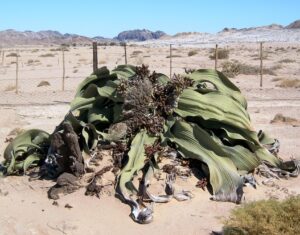
(flickr.com)
Environment: Welwitschia mirabilis is a unique and ancient plant species native to the Namib Desert in southwestern Africa, one of the oldest and driest deserts on Earth. The Namib Desert is renowned for its extreme aridity, receiving minimal rainfall—often less than two inches per year. The temperature in this harsh environment can exceed 100°F (38°C), posing significant challenges to plant life. Despite these severe conditions, Welwitschia has adapted to thrive in this environment, showcasing its extraordinary resilience and ability to survive where few other plants can.
Adaptations: Welwitschia’s most distinctive feature is its pair of leaves, which are the only two it will ever grow and continue to extend throughout its lifespan. These leaves can reach several meters in length and spread across the desert floor. Unlike most plants that shed leaves and produce new ones, Welwitschia’s leaves are persistent and continually replace lost or damaged tissue. This adaptation minimizes water loss, as the plant avoids the energy cost of growing new leaves regularly. Additionally, the leaves’ tough, fibrous structure helps them withstand the desert’s harsh conditions, including strong winds and intense sunlight.
Deep Taproot and Water Access: Another critical adaptation is Welwitschia’s deep taproot, which allows the plant to access underground water sources. This robust root system can penetrate deep into the soil, reaching moisture far below the surface and enabling the plant to survive prolonged periods of drought. Furthermore, Welwitschia has evolved to capture dew and fog, which are common in the Namib Desert. The large surface area of its leaves helps collect these tiny amounts of moisture, providing an additional water source in the arid environment.
Longevity and Ecological Role: Welwitschia is notable for its remarkable longevity, with some individuals estimated to be over 1,000 years old. This extended lifespan allows the plant to endure the desert’s fluctuating conditions over centuries. Its resilience makes it a vital component of the desert ecosystem, offering habitat and food for various desert organisms. Insects and small animals use its leaves for shelter, and its extensive root system helps stabilize the soil, preventing erosion. Welwitschia’s unique adaptations and long lifespan provide valuable insights into plant survival strategies in extreme environments and underscore the incredible diversity of life on Earth.
3. Saltwort (Batis maritime)

(flickr.com)
Environment: Saltwort, also known as Batis maritima, thrives in coastal salt marshes and tidal flats, which are environments characterized by high salinity, fluctuating water levels, and often nutrient-poor soils. These habitats are found along coastlines in tropical and subtropical regions worldwide. The constant influx of salty seawater, combined with the challenges of waterlogging and occasional exposure during low tides, makes these environments particularly harsh for most plants. Despite these challenges, Saltwort has adapted remarkably well, showcasing its ability to survive and even thrive in such demanding conditions.
Adaptations: Saltwort has evolved several key adaptations that enable it to flourish in saline conditions. As a halophyte, it has developed mechanisms to tolerate and even thrive in environments with high salt concentrations. One of the primary adaptations is its ability to excrete excess salt through specialized cells known as salt glands. These glands actively remove salt from the plant’s tissues, depositing it on the surface of the leaves, where it is eventually washed away by rain or dew. This adaptation prevents the toxic buildup of salt within the plant, allowing it to maintain cellular function and overall health.
Succulent Leaves and Water Storage: Another crucial adaptation of Saltwort is its succulent leaves, which are thick and fleshy to store water. This adaptation allows the plant to maintain hydration during periods of low water availability and high salt concentration, preventing dehydration. The water-storing capacity of these leaves also helps the plant survive in the fluctuating conditions of tidal environments, where freshwater may be sporadic. The succulence of the leaves not only aids in water retention but also helps reduce water loss through transpiration, a vital adaptation for survival in saline habitats.
Root System and Ecological Role: Saltwort’s root system is adapted to cope with the often anoxic (oxygen-poor) conditions of waterlogged soils. Its roots can function in low-oxygen environments, ensuring that the plant can absorb necessary nutrients and water even when submerged. Additionally, Saltwort can absorb nutrients from both the soil and the surrounding water, making it highly efficient in nutrient uptake in nutrient-poor conditions. Saltwort plays a significant ecological role in coastal salt marshes by stabilizing the soil with its extensive root system, preventing erosion and maintaining the integrity of the marshland. The plant also provides habitat and food for various wildlife, including birds, insects, and small mammals. Its presence in these ecosystems supports biodiversity and contributes to the overall health and resilience of coastal environments. The ability of Saltwort to thrive in such challenging conditions highlights the remarkable adaptability of plants and their crucial role in sustaining diverse and dynamic ecosystems.
4. Snow Lotus (Saussurea involucrata)

Environment: The Snow Lotus (Saussurea involucrata) is native to the high-altitude regions of the Himalayas, typically found at elevations between 3,500 and 5,000 meters (11,500 to 16,400 feet). This environment is characterized by extreme cold, high winds, intense ultraviolet (UV) radiation, and a very short growing season. The Himalayan highlands experience harsh climatic conditions, with temperatures often plunging below freezing and strong winds creating a formidable challenge for most plant life. Despite these severe conditions, the Snow Lotus has evolved a range of remarkable adaptations that allow it to thrive in one of the world’s most inhospitable environments.
Adaptations: The Snow Lotus exhibits compact growth, forming low, dense rosettes that hug the ground. This growth form is an adaptation to reduce exposure to the cold, biting winds that sweep across the high-altitude regions. By staying close to the ground, the plant benefits from the slightly warmer microclimate near the soil surface. Additionally, the compact growth helps protect the plant from mechanical damage caused by strong winds and reduces heat loss, which is crucial for survival in freezing temperatures.
Dense, Woolly Hairs and UV Protection: A notable adaptation of the Snow Lotus is its dense covering of woolly hairs. These hairs provide insulation, trapping a layer of air that helps to maintain the plant’s internal temperature and protect it from frost. The woolly covering also shields the plant from intense UV radiation, which is much stronger at high altitudes due to the thinning atmosphere. The hairs reflect harmful UV rays, preventing cellular damage and aiding in the plant’s overall survival in the harsh sunlight.
Longevity and Reproduction: The Snow Lotus has a relatively slow growth rate and long lifespan, which allows it to endure the extreme conditions over extended periods. During the brief summer months, the plant flowers and sets seeds rapidly, taking advantage of the short growing season. Its seeds are adapted for dispersal in windy conditions, which helps the plant colonize new areas across the rugged terrain. The Snow Lotus’s ability to survive and reproduce in such a harsh environment highlights its remarkable adaptability and the intricate strategies plants use to thrive in extreme conditions. This resilience underscores the complexity and beauty of life in the high-altitude ecosystems of the Himalayas.
5. Date Palm (Phoenix dactylifera)

(commons.wikipedia)
Environment: The Date Palm (Phoenix dactylifera) is well adapted to arid desert oases, which are characterized by extreme dryness, high temperatures, and limited water availability. These environments are typically isolated pockets of fertile land surrounded by harsh desert landscapes. The date palm’s natural habitat spans across the Middle East, North Africa, and parts of South Asia, where it plays a crucial role in both the ecology and the economy of these regions. The plant’s ability to thrive in such demanding conditions makes it a valuable resource for communities living in desert regions.
Adaptations: One of the key adaptations of the Date Palm is its deep root system. The palm’s roots can extend several meters below the surface, tapping into underground water sources that are inaccessible to most other plants. This deep-root adaptation allows the Date Palm to survive prolonged periods of drought and high temperatures by accessing groundwater that remains relatively stable even during arid conditions. The ability to draw moisture from deep within the soil ensures that the palm can continue to grow and produce fruit even in the driest times.
Leaves and Water Conservation: The Date Palm’s leaves are another crucial adaptation to its arid environment. The palm’s fronds are long and feather-like, with a waxy coating that helps to minimize water loss through transpiration. The shape and structure of the leaves also reduce the surface area exposed to the sun, which helps to limit the amount of water evaporated from the plant. By efficiently managing water loss, the Date Palm can conserve moisture and maintain hydration even in the high temperatures typical of desert oases.
Economic and Ecological Importance: The Date Palm is not only a symbol of life and resilience in desert environments but also holds significant economic and ecological value. Its fruit, dates, are a staple food in many cultures and are highly prized for their nutritional value. Additionally, the Date Palm provides important ecological benefits, such as creating shade and reducing soil erosion in oasis areas. Its presence supports local wildlife and contributes to the stability of desert ecosystems. The Date Palm’s ability to adapt to extreme conditions and its diverse uses underscore its importance in sustaining both human populations and natural habitats in arid regions.
6. Mangrove (Rhizophora mangle)
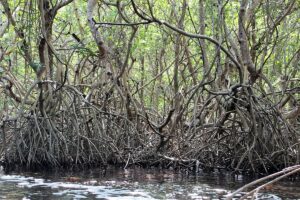
(commons.wikipedia)
Environment: The Mangrove (Rhizophora mangle) thrives in coastal intertidal zones, where land meets sea in environments characterized by brackish water, fluctuating tides, and varying salinity. These regions are often found along tropical and subtropical coastlines, where the interplay of saltwater and freshwater creates a dynamic and challenging habitat for plant life. The mangrove forest plays a crucial role in stabilizing coastal ecosystems, protecting shorelines from erosion, and providing vital habitats for a diverse array of marine and terrestrial species. Despite the harsh conditions, including high salinity and frequent tidal inundation, the Mangrove has developed several remarkable adaptations that allow it to thrive in these unique environments.
Adaptations: One of the most striking adaptations of the Mangrove is its stilt roots, which extend from the trunk and branches into the mud below. These aerial roots provide stability in the soft, waterlogged sediments of the intertidal zone and help anchor the tree against strong tidal currents and storm surges. The stilt roots also assist in the plant’s nutrient uptake by increasing the surface area in contact with the soil. This adaptation allows the Mangrove to maintain its position and stability in the challenging coastal environment.
Pneumatophores and Oxygen Intake: Another key adaptation of the Mangrove is its pneumatophores, specialized aerial roots that emerge above the waterline. Pneumatophores facilitate oxygen exchange in the oxygen-poor, waterlogged soils of the mangrove swamp. These roots are covered with small pores called lenticels, which allow the plant to take in air and oxygenate its root system. This adaptation is essential for the survival of the Mangrove in conditions where the soil is often saturated with water and lacks sufficient oxygen.
Salt-Excreting Leaves and Ecological Role: The Mangrove’s leaves are equipped with salt-excreting glands that help manage the high salinity of the intertidal zone. These glands actively remove excess salt from the plant’s tissues, depositing it on the surface of the leaves, where it is eventually washed away by rain or tides. This adaptation prevents the toxic buildup of salt and helps the Mangrove maintain its health and productivity. Ecologically, mangroves are vital for coastal protection, providing habitat for fish, birds, and other wildlife, and acting as a buffer against storm surges and erosion. Their intricate adaptations and ecological contributions highlight their significance in maintaining the health and stability of coastal environments.
7. Quiver Tree (Aloe dichotoma)
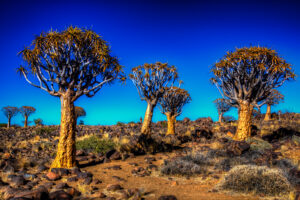
Environment: The Quiver Tree (Aloe dichotoma) is indigenous to the arid regions of Southern Africa, particularly thriving in the deserts and semi-deserts of Namibia and South Africa. These regions are characterized by extreme dryness, high temperatures, and sparse rainfall. The Quiver Tree’s habitat is subject to long periods of drought and intense solar radiation, which presents significant challenges for plant survival. Despite the harshness of this environment, the Quiver Tree has evolved a suite of remarkable adaptations that enable it to persist and flourish in these unforgiving conditions.
Adaptations: One of the key adaptations of the Quiver Tree is its succulent leaves, which are designed to store water efficiently. The leaves are thick and fleshy, capable of retaining moisture during infrequent rainfall events. This water storage capability is critical for the Quiver Tree’s survival during extended dry periods when water is scarce. By accumulating and preserving water in its leaves, the tree can endure prolonged droughts, making it well-suited for the arid environment.
Thick, Cork-Like Bark: The Quiver Tree also features a thick, cork-like bark that plays a crucial role in minimizing water loss and insulating the plant from extreme temperatures. This bark acts as a protective layer, reducing evaporation and shielding the trunk from the intense heat of the sun. The cork-like texture is effective in conserving moisture and helps the tree maintain its vital functions despite the harsh conditions. This adaptation is essential for preventing dehydration and ensuring the Quiver Tree’s resilience in its arid habitat.
Branch Structure and Shade: Another distinctive adaptation of the Quiver Tree is its unique branching structure, which forms a canopy that provides shade to the trunk. The branches grow in a dichotomous pattern, creating a network of shade that helps lower the temperature of the trunk and reduce water loss through evaporation. This shading effect not only aids in water conservation but also enhances the tree’s stability, allowing it to withstand strong winds and occasional heavy rains. The Quiver Tree’s adaptations, including its succulent leaves, cork-like bark, and shading branches, collectively enable it to thrive in the challenging arid environment of Southern Africa.
8. Tundra Rose (Rhododendron lapponicum)

(en.wikipedia.org)
Environment: The Tundra Rose (Rhododendron lapponicum) is a hardy plant that thrives in the Arctic tundra, a region characterized by its cold temperatures, short growing seasons, and permafrost. This environment experiences extreme conditions, including frigid winters, strong winds, and minimal precipitation. The tundra’s low temperatures and nutrient-poor soils present significant challenges for plant life. However, the Tundra Rose has evolved several specialized adaptations that allow it to survive and flourish in this harsh, high-latitude environment.
Adaptations: One of the Tundra Rose’s most notable adaptations is its low-growing, mat-forming growth habit. This growth form helps the plant conserve heat by staying close to the ground, where temperatures are slightly warmer than higher up. By growing in a dense, low-lying mat, the Tundra Rose reduces exposure to the cold winds that sweep across the tundra and minimizes the risk of frost damage. This adaptation is crucial for maintaining warmth and ensuring that the plant can survive the long, cold winters.
Evergreen Leaves and Photosynthesis: Another important adaptation of the Tundra Rose is its evergreen leaves. Unlike many other plants that shed their leaves in the winter, the Tundra Rose retains its leaves year-round. This evergreen trait allows the plant to commence photosynthesis as soon as temperatures rise above freezing, taking full advantage of the brief growing season. The ability to photosynthesize early in the season enables the Tundra Rose to maximize its energy intake and growth before the onset of the next harsh winter.
Woolly Covering and Water Conservation: The Tundra Rose is also covered with a woolly layer of fine hairs, which serves multiple functions. This woolly covering provides insulation, helping to trap heat and protect the plant from the cold. Additionally, the hairs reduce water loss by minimizing evaporation, which is particularly important in the tundra where liquid water is scarce. This covering helps the plant retain moisture, ensuring that it remains hydrated despite the dry conditions typical of Arctic environments. Together, these adaptations enable the Tundra Rose to thrive in the challenging conditions of the Arctic tundra, illustrating the plant’s remarkable resilience and ability to adapt to extreme environments.
9. Baobab (Adansonia digitata)
(flickr.com)
Environment: The Baobab (Adansonia digitata), often referred to as the “Tree of Life,” is native to the savannas of Africa, where it endures the challenges of a seasonal climate characterized by pronounced wet and dry periods. These savannas are defined by their vast grasslands, occasional trees, and fluctuating rainfall. The Baobab’s ability to thrive in such a dynamic environment highlights its extraordinary adaptability to the extremes of both drought and occasional floods. In these regions, where water availability can be unpredictable and temperatures can soar, the Baobab’s unique adaptations enable it to survive and prosper.
Massive Trunk and Water Storage: One of the Baobab’s most remarkable features is its massive trunk, which can reach diameters of up to 11 meters (36 feet). This trunk functions as a natural reservoir, storing large quantities of water during the rainy season. The Baobab’s ability to accumulate and retain water allows it to withstand prolonged periods of drought. This water storage capacity is crucial for survival during the dry season, ensuring that the tree remains hydrated and can continue to thrive despite the lack of rainfall.
Thick Bark for Protection: The Baobab’s thick, fibrous bark serves multiple protective functions. It acts as a shield against the intense heat of the savanna sun and offers protection from fires, which can be common in the dry season. Additionally, the bark helps deter herbivores and pests, providing a defense mechanism against animals that might otherwise feed on or damage the tree. This robust bark is essential for the Baobab’s survival in the fire-prone and wildlife-rich savanna environment.
Leaf Shedding and Water Conservation: During the dry season, the Baobab sheds its leaves to conserve water. This leafless period reduces the plant’s transpiration rate, minimizing water loss through evaporation. By dropping its leaves, the Baobab conserves its internal water reserves, allowing it to survive the extended dry periods typical of its savanna habitat. The tree’s ability to go dormant and reduce water loss during times of scarcity is a critical adaptation that enables it to endure and remain a vital component of the savanna ecosystem. The Baobab’s impressive adaptations underscore its resilience and pivotal role in sustaining life in one of the world’s most challenging environments.
10. Ice Plant (Mesembryanthemum crystallinum)
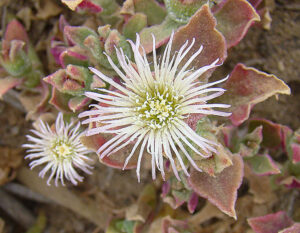
(commons.wikipedia)
Environment: The Ice Plant (Mesembryanthemum crystallinum) is well adapted to the harsh conditions of coastal areas with saline soils, commonly found in salt marshes and coastal flats. These environments are characterized by high salt concentrations, fluctuating water levels, and often nutrient-poor soils. The Ice Plant thrives in these challenging coastal regions, where the combination of saline soil and periodic inundation with seawater creates a demanding habitat for plant life. Its ability to flourish in such environments is a testament to its specialized adaptations for coping with high salinity and water scarcity.
Succulent Leaves and Water Storage: One of the Ice Plant’s most notable adaptations is its succulent leaves. These thick, fleshy leaves are designed to store water efficiently, allowing the plant to maintain hydration during periods of low water availability. The succulent nature of the leaves helps the Ice Plant endure the saline conditions of its environment, where freshwater can be sporadic and saline intrusion is common. By retaining water within its leaves, the Ice Plant can survive the osmotic stress imposed by the saline soil and fluctuating water levels typical of coastal habitats.
Salt Glands and Excretion: The Ice Plant has developed specialized salt glands on its leaves to manage the high salinity of its environment. These salt glands actively excrete excess salt that the plant absorbs from the soil, preventing the accumulation of harmful salt concentrations within its tissues. The excreted salt is deposited on the surface of the leaves, where it forms a crystalline coating that gives the plant its distinctive appearance. This adaptation is crucial for maintaining the plant’s internal osmotic balance and ensuring its survival in saline conditions.
CAM Photosynthesis and Water Conservation: Additionally, the Ice Plant utilizes Crassulacean Acid Metabolism (CAM) photosynthesis, a water-conserving pathway that allows it to photosynthesize efficiently in arid and saline environments. CAM photosynthesis enables the plant to open its stomata (pores) during the cooler, humid nighttime hours to take in carbon dioxide, which is then used for photosynthesis during the day when stomata are closed to reduce water loss. This adaptation helps the Ice Plant conserve water while still producing the energy needed for growth and survival in its challenging coastal habitat. The Ice Plant’s suite of adaptations, including succulent leaves, salt-excreting glands, and CAM photosynthesis, underscores its remarkable resilience and ability to thrive in extreme environments.
Conclusion,
The ten plants highlighted in this article showcase the extraordinary adaptability and resilience required to thrive in extreme environments. Each species, from the water-storing Baobab of the African savanna to the salt-excreting Ice Plant of coastal salt marshes, represents a unique evolutionary response to its harsh habitat. These adaptations not only allow them to survive but to flourish where many others would falter. By studying these remarkable plants, we gain valuable insights into the incredible diversity of life and the ingenious strategies that nature employs to overcome environmental challenges. Their ability to thrive in such diverse and often harsh conditions underscores the intricate balance and adaptability of ecosystems, offering inspiration and lessons in resilience. As we continue to explore and understand these plant adaptations, we deepen our appreciation for the natural world and the remarkable feats of survival that shape our planet’s most extreme environments.
